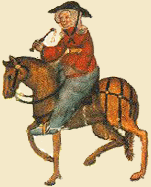




 |
 |

 |
 |
|
Dame Ragnell
and Alison's Tale
|
 |
In Chaucer's The Canterbury Tales, the Wife of Bath (Alison) teaches her audience what it is women most desire through her tale. The tale she tells resembles the tale of Dame Ragnell. These stories are analogies, perhaps both arising from a similar folk-tale source. Both stories are set in the magical Arthurian times when the fields and forests teemed with gnomes and unearthly creatures. Although both stories have the same moral and end on similar note, there are some vivid differences that we simply cannot overlook.
It is very possible that Alison's tale is a custom tailored version of the Dame Ragnell story. The knight in "The Wife of Bath's Tale" is portrayed as a selfish hedonist whose behavior is anything but courteous. It seems as if Alison twists the story of Dame Ragnell to suit her own selfish needs and makes the point that "men are scum" for her tale begins with a noble knight of king Arthur's court raping a maiden:
And so bifel it that King Arthour Hadde in his hous a lusty bacheler That on a day cam riding fro river, And happed that, alone as he was born, He sawgh a maide walking him biforn; Of which maide anoon, maugree hir heed, By very force he rafte hir maidenheed; Norton, 888-894.
As a result of the knight's behavior, the queen gives the knight an ultimatum. He now must find "what thing it is that wommen most desiren" within a twelve months time frame (Norton, 911). Alison does not depict the knight in the nicest light. I guess she is the one "painting the lion" in this case.
Unlike "The Wife of Bath's Tale," the story of Dame Ragnell portrays Sir Gawain as an exemplary hero who is loyal to his King beyond belief. Sir Gawain promises to marry the loathsome Dame Ragnell in order to save the King's life and illustrates his devotion to the king by following up on his promise. When King Arthur gives Gawain the horrific description of the foulest maiden ever seen by men and poses the question to Gawain, Sir Gawain's reaction is the quintessence of loyalty:
'Gawen, I met today with the foulest lady That evere I sawe sertenly. She said to me my life she wold save… But first she wold thee to husbond have. Wherfor I am wo begon- Thus in my hart I make my mone.' 'Is this all?' then said Gawain; 'I shalle wed her and wed her again, Thoughe she were a fiend'… "Wedding," 336-344.
It is evident from the above quotation that Sir Gawain possesses all the manners that the knight from Alison's tale lacks. Here, too, the characters must find out what women most desire, and one ends up marrying the ugly maiden who provides the answer. But, unlike the lusty rapist knight in Alison's tale, the knight in this story is of higher morals and repute.
The knights of both stories are faced with a quandary once they marry their ugly wives. In "The Wife of Bath's Tale," the old hag asks her husband to choose whether he wants her old and ugly but faithful, or young and beautiful but unfaithful:
'Chees now,' quod she, 'oon of thise thinges twaye: To han me foul and old til that I deye And be to you a trewe humble wif, And nevere you displese in al my lif, Or elles ye wol han me young and fair, And take youre aventure of the repair That shal be to youre hous by cause of me- Or in some other place, wel may be.' Norton, 1225-1232.
In a similar fashion, Sir Gawain must also make a decision as to whether he wants his wife, Dame Ragnell, to be beautiful by night but loathsome by day or vice versa:
'Sir,' she said, 'thus shalle ye me have; Chese of the one… …Wheder ye wolle have me faire on nightes And as foulle on days to all men sightes Or els to have me faire on days And on nightes on the fouliost wife, The one ye must nedes have.' "Wedding", 656-663.
Although the above choices presented to each knight by his wife seem to convey a similar underlying message, it is important to identify the difference between these instances. The choices that the wife of each knight makes available are designed to directly challenge each knight's behavior and character. For instance, Sir Gawain is presented as an honorable knight; therefore he must choose between compromising his reputation and putting up with a loathsome wife at night. Alison's knight, however, is not given the same choice because he loses his honorable reputation when he takes dominance and rapes a maiden. Since he is driven by a desire to dominate and derive pleasure, he too must chose between the things that he is made of. Should he choose beauty, he loses dominion for he will be a cuckold. Should he chose dominion and faithfulness, he will have to spend many years with an old hag.
Both "The Wife of Bath's Tale" and "The
Wedding of Sir Gawain and Dame Ragnell" probably come from the same source
of long forgotten tales about King Arthur. Although both tales have similar
plots and the same underlying moral message, we must pay heed to the differences
in these stories. We must acknowledge the tales' similar story-line but we
must also examine the dissimilarities that we meet along the way, for these
differences may tell us a story of their own. Although both tales incorporate
supernatural elements that coexist with the human, earthly qualities of our
knights, they are two different tales illustrating two different points and
reveal to us a little something about the tales' authors.
[Home] [E-Mail
the Author] [Sources]